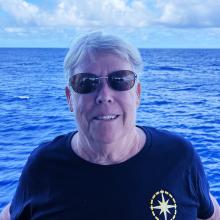
Joyce Miller
Tell us about your work/research. What kinds of things do you do?
Since the early 1980s I have been working in multibeam mapping for academic, governmental, and commercial organizations. My education includes a Master's in German education and Master's work in Marine Geophysics. Early (1980s) multibeam mapping projects were primarily for deep sea geological research. In the 1990's I was part of a team that conducted the first commercial shallow water multibeam surveys for NOAA's Office of Coast Survey (OCS). In the 2000's I led multibeam benthic habitat surveys for coral research in the 50 U.S.-affiliated Pacific Islands. My work has primarily been on data collection and processing applications. Since 2012, I have led or participated in numerous Extended Continental Shelf and manganese module expeditions throughout the Pacific. Although I am "officially" retired I am still active in multibeam expeditions.
What sparked your initial interest in your career?
In 1970/71 I spent two years on the coast of Liberia, West Africa, as a Peace Corps teacher. Being from Indiana it was my first experience near the ocean, but I had always loved the water. My educational background was German education and I had no background in geology or science. When my students asked why the ocean was salty, but the rivers were not, I couldn't answer. So I decided to learn about the ocean and travelled to Hawaiʻi, where my sister lived, to attend graduate school. Marine geology was my major, but really I was fascinated by working at sea and mapping the ocean floor and have since spent somewhere between 15 and 25 years at sea, including 10 years living on a 50-ft boat and sailing from Rhode Island to Hawaii. Here in Hawaiʻi I worked in mapping coral reefs and am still going to sea and volunteering at the Hawaiʻi Institute of Marine Biology.
Who influenced you or encouraged you the most?
Like so many who grew up in the "new" television age, I watched Jacque Cousteau and Sea Hunt avidly. My parents encouraged my sisters and me to get an education and to follow our dreams. Although I wish I could point to positive mentors and influences in my early career, as a woman going to sea in the mid-1970's and working in a male-dominated field, there were many less-than-encouraging and sometimes outright discriminatory experiences, which made me more determined than ever to do well. On the positive side, I met my husband, who has been very supportive of my career, on a ship with the first NOAA multibeam system and we have worked together in the multibeam mapping community for 40 years. I also had the very rewarding experience of serving on and eventually chairing the NOAA Hydrographic Services Review Panel (HSRP) for eight years (2011-2018). Working with Admirals Glang, Smith, Brennan, Evans and Gallludet, and the NOAA staff, who are all committed to improving our nation's oceanographic services and promoting diversity in the field, was a very positive experience.
What element of your work/study do you think is the most fascinating?
Surveying around the coral reefs in the Northwestern Hawaiian Islands and Pacific Remote Island Areas and active volcanoes in the Mariana Islands in a 25-foot survey launch was an incredible experience. Many of these areas had never been surveyed and we were able to provide the data that was collected for habitat mapping to the Office of Coast Survey to update nautical charts.
How did you get involved with the Ocean Exploration Trust?
I have worked on many oceanographic vessels including volunteering on NOAA's Okeanos Explorer and on the R/V Falkor. Through Derek Sowers and Dan Wagner, I connected with the OET and Nautilus.
What other jobs led you to your current career?
Surprisingly, my background in German, language, and education has been a valuable resource in my technical career. As part of my work, I have written or coordinated numerous manuals, papers, and reports and am comfortable with writing, which is often not the case for technical scientists. As part of the HSRP, I authored a number of white papers on hydrographic issues. I have also had the opportunity to lead and conduct numerous training courses in the U.S. and the Philippines. Thanks to my fluency in German, I have been involved in several German-led manganese nodule expeditions.
What are your degrees and certifications?
B.S. and Master of Science in German Education, Indiana University, 1968 & 1969.
Master's work in Marine Geology, University of Hawaiʻi, 1974-1979.
What are your hobbies?
Practicing, learning, and teaching tai chi is my passion, and it keeps me healthy and in touch with many friends. I also make Hawaiian feather lei and hat bands and love to listen to live Hawaiian music. I enjoy volunteering and giving tours at the Hawaii Institute of Marine Biology. I also like to do at least one research cruise each year. I'm told I'm a pretty good cook too.
What advice would you give someone who wants to have a career like yours?
If you want to be a sea-going scientist, one of the most important skills is flexibility, because the only thing you can count on with ships is that things will change. Collect as many "skill tools" as possible during your education, since you never know what might be the secret to getting a job. No matter what scientific field you are interested in, learning computer skills is an absolute requirement. Develop writing and communications skills, which are required in almost every field. If you want to get an internship or job with a specific group, research what that group is doing and show your interest in their work.
Expeditions
Joyce participated in the following Ocean Exploration Trust expeditions:
